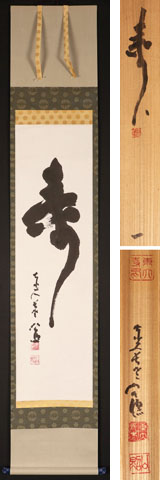Zenga
Mu - DreamSigned: Tôdai Chôrô Kôshô
Seals: Tôdai Chôrô, Kôshô, Kanchû setsu (tp)
Technique: sumi on paper 113.2 x 31.5
Mounting: green brocade and grey silk 194 x 35.8
Box: signed
Condition: a horizontal crease, otherwise very good
Box inscription outside: Mu ichi, seal: Kôshô, inside: {signed:] Tôdai Chôrô Kôshô
seals: 東大寺印、東大長老、公照、Tôdaiji in, Tôdai chôrô, Kôshô
Mu means: The empty transciency of things - that melt away in a moment.
It also indicates the state of freedom from thoughts and desires.
Hopes painting the future. (Lewis, Zen grove handbook)
Shimizu Kosho was born in the famous castle town of Himeji on January 3rd, 1911 and entered Todai-ji-Temple in Nara in 1927. Upon graduation in Buddhist studies from Ryokoku University in 1933 he took up residence at Tenryu-ji for four years to study and practice Zen under the guidance of the Abbot Seki Seisetsu (1877-1945). When he returned to Todai-ji, the first steps of his career were closely linked to the temple's teaching institutions. In 1947 he became Director of the school (which was later to become the still existing Todai-ji High School). In 1959 he was appointed the Director of the Monks' Academy (Kangakuin) at Todai-ji, and in 1963 became Director of Todai-ji Girls' School and Todai-ji Kindergarten. 1969 marked a turning point in Kosho's career, when he was appointed as Head of Religious Affairs of the Kegon Tradition. In 1975 the Abbot Kamitsukasa Kaiun (1907-1975) died and Shimizu Kosho was chosen as his successor, becoming the 207th Abbot of Todai-ji. He remained in this position for only a short time, resigning in 1981.
For the remaining nearly twenty years of his life, Shimizu Kosho was dedicated to the life of an artist. He became a prolific "eccentric" painter, calligrapher and figurative potter. Unlike most artist-monks, he did not limit himself to painting in only black ink, but enjoyed a full range of colours. His writing and painting styles are what may be described as obsessively impulsive. His clay figures are charmingly naive and sculptural refinement was clearly not one of his aims. In 1994, when the Shosha Art and Craft Museum (in Himeji, Hyogo Prefecture), was founded, Shimizu Kosho was made its honorary director because he donated a large number of his artworks. He died on May 6th, 1999.
Price: SOLD

